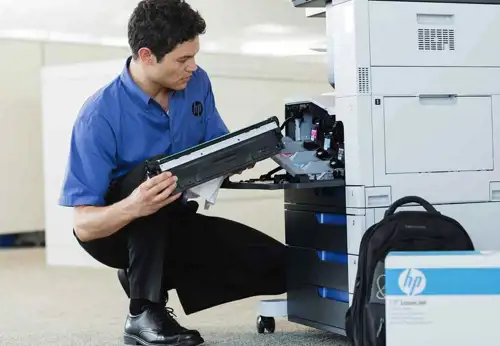What to Look for in a Good Managed Print Provider
What to Look for in a Good Managed Print Provider
Have you ever interviewed an outside firm to handle your print and copier devices without real knowledge of what to expect from a service provider? It can be a stressful decision. If you haven’t been through an MPS search, this article will save you some anguish and help you select the best managed print services partner for your business.
Hopefully your business won’t have to repeat the process multiple times, and we don’t want you to regret your decision. With the advice in this article, you’ll connect with the best MPS partner early in your search and enjoy a long, satisfying relationship.
How Long Do MPS Relationships Typically Last?
How often do businesses actually go on the hunt for an MPS partner? If you have a good partnership, strong relationships can last 5-10 years or even longer. Typically they last quite a while, in part because the best MPS partners do a good job for the customer, meaning they have gotten the IT department out of print-related problems and issues. They have a game plan around helping drive out costs, which a professional organization would if they’re doing those two things.
They’re going to understand more about that customer’s print environment, from little things to larger items than any potential prospective competitor would. It’s a sticky relationship. When the partner truly adds value, there’s no need to go shopping.
Top Two Reasons a Business Searches for MPS Partner
Usually the motivation is financial, or the business needs additional support for existing devices.
1 – Too Many Devices, Too Many Costs
If leaders think they have too many devices, and costs for print relative to organization size are exorbitant, they will likely go looking for a solution to drive out some of those costs.
A lot of businesses recognize they have an issue; they just don’t quite know what that is. No one in the organization is trained to do a full fleetwide analysis. By talking to prospective partners, they can start working with a professional organization that can define the problem and continue to drive out costs. That’s a financial reason to look for an MPS partner.
2 – Older Fleet Needs Constant Service
The second reason we often see searches happen is if the business has an older fleet, and printer service calls for the IT department are becoming too much. Sometimes 40% level of service tickets have to do with print devices.
IT and financial managers want an organization to take that off their hands, so they can focus on more pressing items such as network connectivity, or software solutions, or whatever it is that’s important to them beyond just printers.
Who Should Be on Your MPS Search Committee?
The MPS search committee depends on who in that organization is touching devices at the moment.
Usually it is somebody in the IT department for larger organizations who are responsible for maintaining the equipment. Usually someone in the administrator department is in charge of ordering supplies for the equipment and making sure they have what they need in that regard.
And then the last is probably somebody in the finance department. And there could be overlap. The financial spin on print devices was hitting IT well, IT might just be it and they can make a decision.
If the decision has nothing to do with repairing or outsourcing to another organization, but it’s financially impactful, it might just be a CIO. It really just depends on whose department is affected.
What to Ask Before Hiring an MPS Partner
How can you tell you’re talking to somebody who knows what they’re doing? These questions will help companies make the right MPS choice the first time.
How does a typical service call flow
One question companies should ask about MPSs in their vetting process but rarely do, is how does a typical service call flow from start to finish? How do they handle that? That’s really extremely important to know and set expectations.
Understand Their Auto Toner Replenishment Process
They should ask and completely understand about the auto toner replenishment process that is part of MPS. Customers assume it’s a perfect process and they never have to worry about ordering toner again. That’s not the case. You can be really good at it and still have holes. Printers come online; cartridges get lost, but they need understanding of what happens when that happens. Problem solving is as important as problem avoidance.
How Does Provider Handle Tech Training and Development?
The frontline techs who support your printers and other devices have a critical role. Are they currently trained or certified on the brands of equipment they support? That’s just a basic question to ask right away.
A good follow-up question would be what is their training cadence? How often do you provide training to technicians? Are they training every six months? Are they training only when devices are launched?
Signs of Good MPS Manufacturer Relationships
How can you tell if a provider has strong relationships with device manufacturers, like HP, Canon or others? That matters because it affects product delivery for one thing.
Every business has a heightened understanding of thefree flow of products in today’s market, because nearly every manufacturer struggles with supply chain fulfillment. Smaller dealers that don’t have deep relationships with manufacturers they represent are probably not going to have very good answers about when they can get equipment to you. Is the dealer delivering for their customers today?
In a typical, normal, non-COVID world. What kind of pricing support can the manufacturer offer the particular customer? What type of software support is necessary? Can they bring in the manufacturer or representative from the manufacturer to support them in areas that they’re experts in?
How Can You Verify Partner Claims about Service Response?
You can ask a potential vendor about KPIs but, in many ways, these performance indexes are just self-reporting. A better option to verify is to request referrals within your industry and space. Call and ask how the provider is doing for them on the service aspect. How does that flow, and if it matches up with what the vendor’s proposing, you’ve done a good job verifying it.
Watch for These Red Flags When Talking to MPS Providers
Over promising on savings is the biggest red flag in MPS conversations. A potential partner claims they can save you 20-30-40%, but has yet to even understand what you’re doing today. That’s a red flag. They’re just citing industry statistics.
Another red flag would be if the vendor stumbles and doesn’t have a good answer for their processes around service. You don’t want a reactive-only partner.
What Are Green Flags? Signs an MPS Provider Knows What They’re Doing
One clear sign is that they are very candid with their responses. If you ask a vendor how much they can save you, and they say they don’t know until they dig in and understand, that’s probably an experienced MPS provider. That partner will want to know:
- What your current current environment looks like
- How are you buying supplies?
- How are you doing service now?
- What is your fleet makeup?
- What are print volumes going to be?
That’s a sign they understand what they’re doing. They ask questions before making promises to you.
Here’s another way to know you’ve got a seasoned MPS team. When they start an MPS program, the very next thing they do is scheduling a review. Once they start, a good provider should schedule 30-60-90 day reviews, and then every quarter thereafter. They will want to discuss strategies with you and how to print more efficiently or more securely, or whatever your goals are.
Want to talk about your goals for managed print? We think you’ll find we know what we’re doing.








